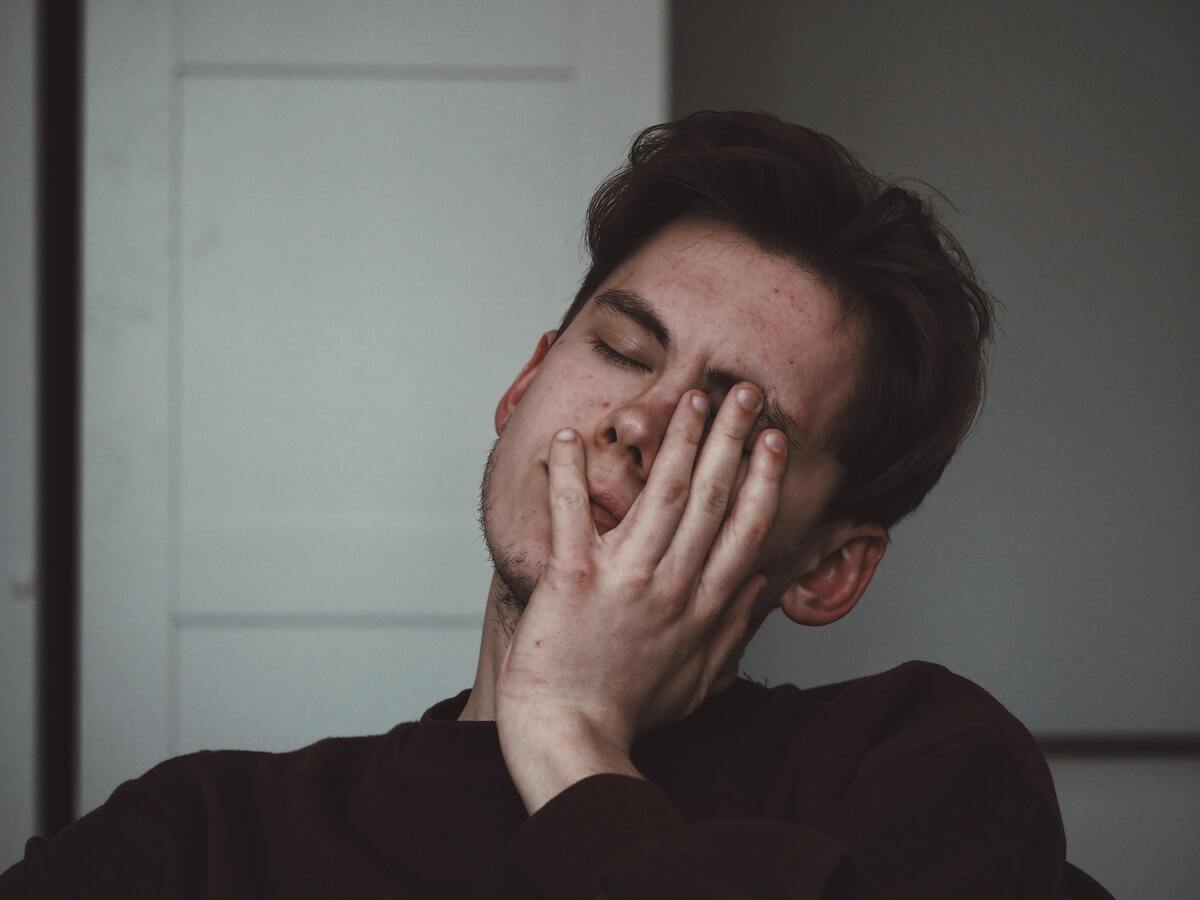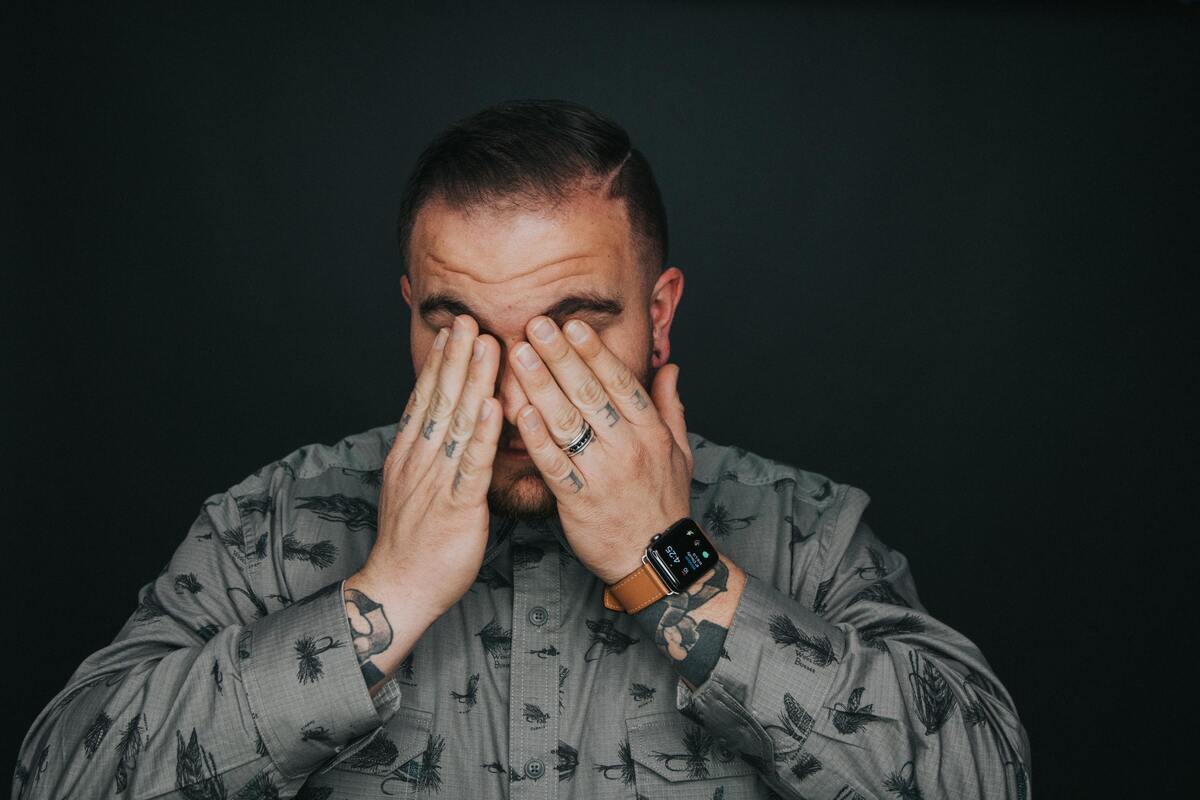Table of contents
General considerations about migraine with aura

Most likely you have experienced headaches and know how uncomfortable it can be. Recurring headaches can be migraine, a neurological disease that requires specific care.
Migraine with aura, in turn, is characterized by visual and sensory symptoms before the migraine attack itself. Many people suffer from this disease and don't know it, so they end up not getting the proper treatment.
In this article we will explain in detail what migraine with aura is, what its phases are, the causes and the recommended treatments. In case you suspect you have this condition, or know someone who does, read on to learn how to deal with this problem!
Understanding Migraine Phases

Migraine with aura is a very characteristic neurological condition. People who have this problem report vision changes, besides the headache itself. Did you know that migraine with aura has four phases and that identifying them is essential to help in the treatment? Read and understand!
Premonitory phase (Prodromo)
The first phase of migraine can occur up to 72 hours before the headache appears. The premonitory phase brings symptoms such as fatigue, difficulty to concentrate, irritability, frequent yawning and desire to eat sweets.
The aura phase
The aura phase is what characterizes this type of migraine. At this moment, the individual gradually starts to observe black or bright points and zigzag images. Besides the visual aura, it is also possible to feel the sensorial alterations that include numbness and tingling in only one side of the body and that progressively spread.
Another type of aura is that of language, which manifests itself through difficulty in pronouncing some words, a phenomenon called dysarthria. It is also possible that the person tries to speak some words, but the sounds come out differently than usual and incomprehensible.
Headache (headache)
The moment following the aura phase is, in fact, the headache. The so-called headache comes after the visual, sensory, and language symptoms. It can occur in various forms, but usually it happens on only one side of the head and it is throbbing and intense.
It is common for people in this phase to be sensitive to light, sounds and smells. They feel irritated by any visual, sound or smell stimulus. Soon, they seek to isolate themselves in dark, quiet places in an attempt to relieve the headaches.
Headache can last up to 3 days and this is when most people seek medical attention. In some cases the headache is so bad that other symptoms such as nausea and vomiting can appear.
The resolution
The last phase of migraine with aura appears right after the improvement of the headache. In this phase the symptoms are similar to the first one, the person feels unwell, fatigued and sleepy. It is also known as migraine hangover and these symptoms can last up to two days.
Migraine with aura, symptoms, diagnosis & prevention

As seen, migraine with aura is composed of several phases, but many people only seek medical attention at the moment of intense headache. To facilitate the diagnosis, and consequently the treatment, it is necessary to know in depth each symptom of this type of migraine. Read on to understand!
What is migraine with aura
Migraine with aura is one of the types of headaches that affect people. It is distinguished by its visual and sensory symptoms, which include lights, bright or zigzag images. These symptoms precede the headache phase, before the headache itself appears.
Type of migraine is also considered a neurological disease that should be diagnosed and treated with medical monitoring. After all, its symptoms are extremely debilitating.
Contrary to what many people think, migraine with aura affects about 30% of the population who suffer from migraine, and most of them are women. Therefore, its symptoms are considered very common for those who have this clinical picture.
The symptoms of migraine with aura
There are several symptoms of migraine with aura and they depend on the stage of migraine. At first, fatigue, irritability and drowsiness are the most common symptoms. Then, the striking lights, flashes and spots usually affect patients.
In the sensory phase, tingling and numbness are reported in the hands, arms, and face. Language symptoms include difficulty pronouncing some words. Finally, severe headache on one side of the head is the most terrible symptom of migraine.
Other symptoms that may accompany migraine with aura are:
- Low blood pressure;
- Chills;
- Nausea;
- Vomiting;
- Sensitivity to light, sounds and smells;
- Loss of appetite;
- Excessive sweating;
Remembering that some of the symptoms may remain for a few days, even after the headache has improved.
The diagnosis of migraine with aura
To confirm that a person has migraine with aura, a neurologist will perform a clinical analysis and some tests. He or she will probably ask about the frequency of the headache; how long it lasts; whether it occurs on both sides of the head; and whether there are visual, sensory, and language symptoms.
To ensure that there is not an even more serious condition behind the migraine with aura, the doctor may order blood tests and imaging tests such as CT, X-ray and MRI.
Moreover, other issues must be addressed in the anamnesis, such as the patient's family history, allergies, use of medication, patient's routine and other habits that may influence the frequency of migraine with aura.
Prevention
The first step in preventing migraine with aura is to find the triggers responsible for triggering the attacks. After the tests rule out possible diseases, it's time to carefully analyze which habits cause the migraine.
Self-knowledge in this phase is fundamental to discover the possible motivations that trigger this crisis. This will help to identify if this headache was caused by some food, medication, emotional triggers, consumption of alcohol or drugs, and even environmental factors such as changes in temperature and pressure.
In this way, it will be possible to avoid these situations or, if it is impossible at some times to avoid the triggers of migraine with aura, to be able to use medication in a timely manner to prevent the headache.
Possible causes for migraine with aura

There is no single, exact cause for migraine with aura, but scientists and doctors list several factors that can trigger or increase migraine with aura. If you suffer from this condition, follow this section to see if your migraine is related to any of these factors!
Specific foods and beverages
The consumption of alcoholic beverages, especially when frequent, can trigger migraine attacks, including migraine with aura. Other foods that are put as possible causes of migraine with aura are:
- Citrus fruits;
- Banana (mainly the water kind);
- Cheese;
- Sausages, sausages and other heavily seasoned foods;
- Fries and fats;
- Coffee, teas and soft drinks;
- Artificial sweetener, mainly aspartame.
One way to analyze if food or drinks influence the appearance of migraine aura, is to elaborate a table with your daily feeding and observe in the base of the trial and error which foods can be influencing in the appearance of the crisis.
Eating habits and sleep routine
Besides the food itself, keeping unregulated eating habits can also trigger migraine with aura. Therefore, it is important to avoid consuming foods rich in saturated fats and carbohydrates, opt for healthy and natural foods, besides eating every 3 hours.
Sleeping habits are also determinant for the appearance or not of headache crises. Sleeping more or less than necessary disrupts the body, leading to migraine. Keeping your routine organized will allow your diet and sleep to be regulated.
The sudden variations in air temperature and humidity
Another factor that is often unknown to people is the action of changing pressure, temperature and humidity. Leaving a hot environment and entering a cold one, or the other way around, can cause migraine attacks with aura.
Another action that can cause these intense headaches is to ingest cold liquids with an excessively hot body. Therefore it is interesting that you avoid thermal shocks, as they can deregulate your body and its metabolic functions.
Hormonal, emotional factors and stress
Women are the ones who suffer most from migraine attacks. This happens mainly because of the hormonal variations that occur during the menstrual cycle. Especially in the premenstrual period, or during menstruation, the pains can be more frequent or more intense.
This happens due to the reduction in the production of estrogen hormone, which occurs mainly at the beginning of the use of oral contraceptives. Moreover, in the menopausal period and hormone replacement women can also suffer with these crises.
The treatment of migraine with aura

The treatment for migraine with aura involves several steps. They include not only medication, but attitudes and habits that you can include, or remove, from your routine. Read on and understand the main treatments for this migraine.
Consult an expert
The first step for the treatment of migraine with aura is to seek professional assistance. Only through a medical consultation and a detailed battery of tests you will be able to observe if the origin of the problem is physiological or psychic.
After all, before taking any action, it is necessary to rule out other problems that may be triggering migraine attacks with aura. Once the exams are done and the patient is evaluated, the doctor will be able to build the ideal strategy to avoid the crises and minimize the symptoms if they occur.
Take medicine when directed by your doctor
If your doctor prescribes any medication to control migraine with aura, make sure you always have it nearby and take it as prescribed. As seen, migraine with aura occurs in four phases, and the drugs are much more effective when taken early, until the second phase.
If the headache has already started, it will be much more difficult to control it, as well as the adjacent symptoms such as nausea and vomiting. The most common medications for migraine with aura are neuromodulators, beta-blockers, ergotamine derivatives, antihistamines and anticonvulsants.
However, they should be taken only with a doctor's prescription, since each one has a different action in the body, depending on what triggers the migraine in the individual in question.
Understand what relieves your pain
There are some treatments that do not use medication to relieve your pain. They are: massage, homeopathy, acupuncture, biofeedback therapy, compresses. You can resort to them if you feel impaired by medication.
However, it is worth remembering that the agents responsible for triggering the migraine may vary from person to person. In order to understand what relieves your pain, it is important to look for the most efficient tool for you. Start with the one that gives you the most confidence, that's a good start.
Treat symptoms separately
Painkillers are effective in treating the pain of migraine with aura, however, there may be other symptoms that need to be treated. So, to relieve them you will need to take a separate treatment.
Rest in a dark and quiet place
It is very common that you seek to stay away from noisy and brightly lit environments while experiencing a migraine attack with aura. Since sound and light can intensify your pain, you will need to create an ideal environment to deal with your problem.
Therefore, seeking rest in dark and quiet places can ease the pain. You will find comfort in isolation and be able to rest until the pain passes.
Eat light meals and stay hydrated
In many cases, migraine with aura causes pain so intense that it makes you nauseous and vomit. If you have reached this point, try to stay hydrated with plenty of fluids and avoid heavy meals to prevent motion sickness. Drinking water and fruit will help you deal with the pain in a lighter way.
Medications commonly used in the treatment of migraine with aura

There is still no specific treatment that is indicated for all cases of migraine aura. For, depending on the body of people there will be different medicines and ways to relieve pain. However, there are common medicines that can help treat migraine. Follow and find out what they are!
Anti-inflammatories
Anti-inflammatory drugs are great medications to be used in milder or moderate migraine attacks with aura. They are able to ease or prevent inflammatory reactions in the body, besides being widely used drugs to combat headache.
For, there are substances in its composition such as ibuprofen and acetaminophen. That will act actively in relieving inflammation in the membranes that cover the brain, also reducing the reproduction of substances responsible for pain.
Opioids
Codeine, on the other hand, which is part of the opioid family, are perfect for cases of migraine with very intense aura. Codeine, also known as codeine phosphate, is widely used in cases of acute and chronic pain.
However, it is not usually used when other treatments are being done, and may only be used as a last resort when other remedies do not seem to work.
Tryptans
Triptans are part of the tryptamine family and are widely used in the treatment of migraine and headache. Although they are effective in combating headaches, they are only effective in preventing them. When it comes to tryptans such as rizatriptan, or sumatriptan, they are medicines with a very positive effect.
This substance has the ability to reduce the production of the substances that generate pain in migraine attacks with aura. Therefore, they are widely used in moderate, severe or chronic crises.
Antiemetics
Antiemetics, such as Plasil or Dramin, are drugs that are intended for the relief of nausea and vomiting. Used in the prevention of nausea and vomiting of pregnancy, or caused by medication, or post-surgery. Also being recommended for people undergoing radiotherapy.
They are usually administered in conjunction with anti-inflammatory drugs and triptans to assist in relieving the symptoms presented in a migraine attack.
Curiosities and additional information about migraine with aura

Migraine with aura is a condition that accompanies many people throughout their lives. When the diagnosis is not made and treatment is performed palliatively, it becomes very difficult to completely eliminate the symptoms.
There are also some curiosities about this disease, such as its improvement during pregnancy and the representation of migraine with aura in works of art. Read on to learn more!
Why migraine improves in pregnancy
Migraine attacks with aura usually decrease during pregnancy because there is a hormonal regulation of estrogen in the blood, thus allowing vessel dilation and preventing headaches.
However, if the flares recur during pregnancy, it is recommended that you see your gynecologist. He will be responsible for analyzing the hormone levels in your blood, and if necessary, estrogen replacement will be done.
Works of art and migraine with aura
Due to the various visual, sound and spatial alterations that occur before the onset of the migraine attack with aura, these sensory distortions will become objects of inspiration being reproduced by some authors and artists recognized worldwide.
As, for example, in works such as Alice in Wonderland, written by Lewis J. Carroll, which describes objects and other elements with variations in size, color and shape in a completely absurd way. Another well-known reference is the wonderful work "Starry Night" by Van Gogh.
Possible complications
Chronic migraine itself is benign and not a major risk. However, severe and frequent headaches can be signs of neurological problems that should be investigated as soon as possible. If you experience headaches frequently, be sure to consult your doctor.
In addition, if migraine with aura goes untreated, it can increase the risk of heart attack in some cases. Women under the age of 35 who take oral contraceptives should also see their gynecologist if headaches are frequent.
Can migraine with aura cause stroke?

A stroke happens when the brain no longer receives blood with the nutrients and oxygen necessary for its maintenance. It can be caused by obstruction of blood flow, or by rupture of vessels in the brain, thus causing the death of brain cells.
Some believe that migraine with aura can cause a stroke. However, this condition is rare and, if related to migraine, may signal the presence of other diseases or degrading habits to the body.
The relationship that occurs between these two conditions is that they can be triggered by the same factors. That is, a person who smokes, has poor eating and sleeping habits, or a woman who uses oral contraceptives, face a higher risk of both migraine with aura and stroke.
So, cultivating healthy habits and having routine check-ups is the key to avoid both situations. If you suffer from migraine with aura, be sure to seek treatment and identify which triggers, physical and emotional, trigger your attacks. This will help you live better!

